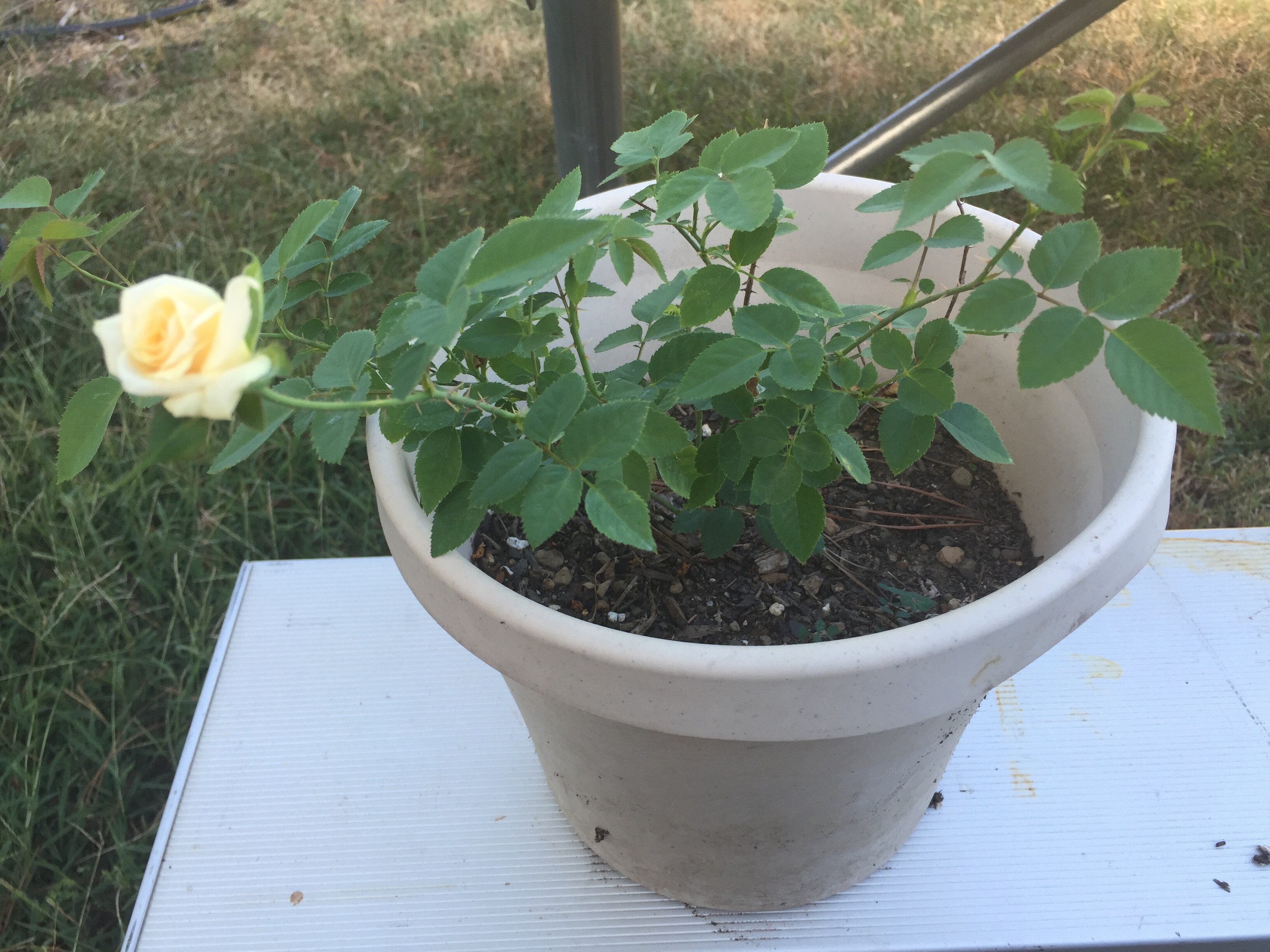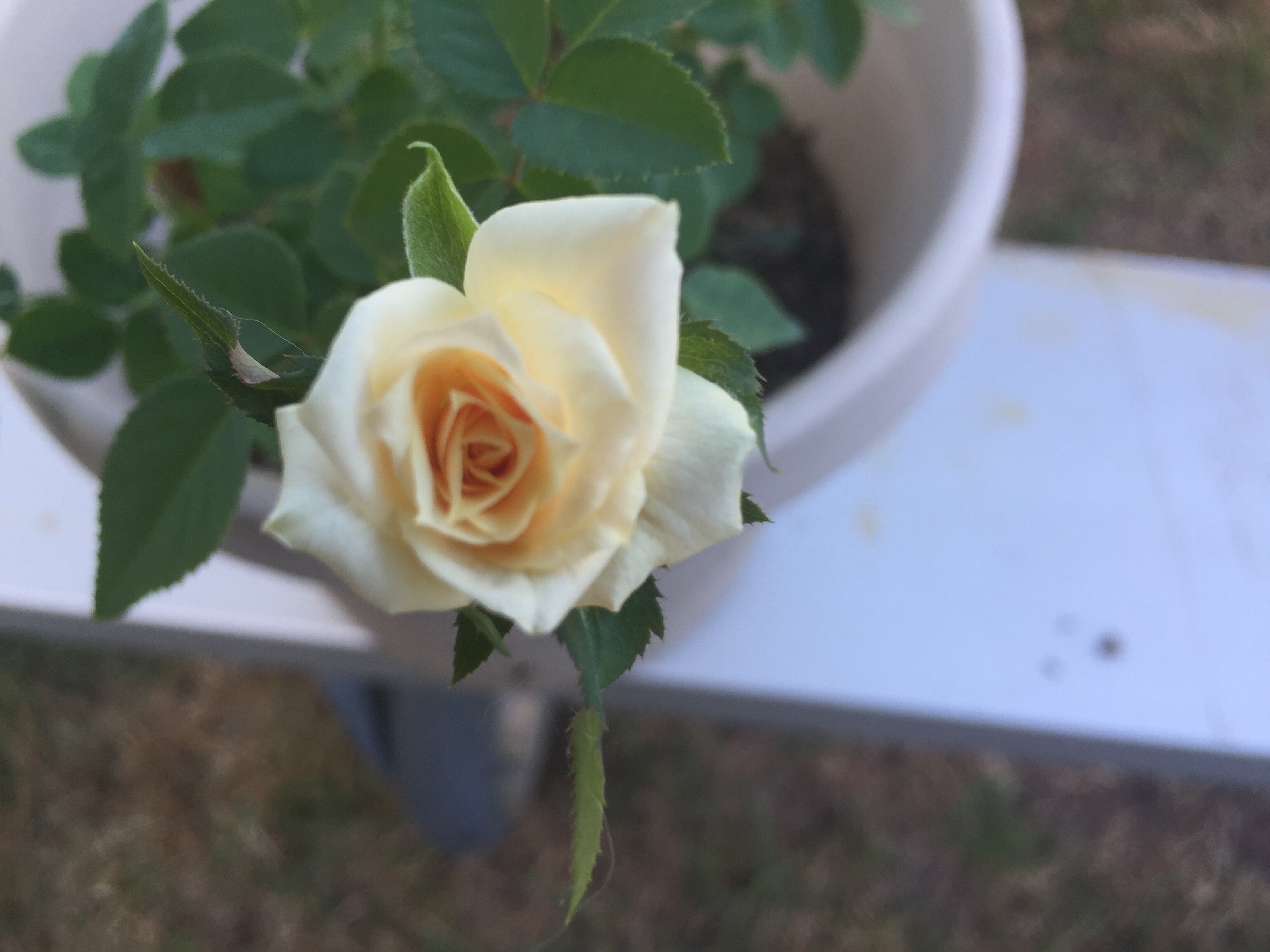[attachment=0]09-13-01 (2).JPG[/attachment][attachment=1]09-13-01 (3).JPG[/attachment]One of my hybridizing goals has been to develop a yellow china. First off, china roses do quite well in my zone. Second, I like yellow roses and there are very few yellow chinas. This is a cross I did in 2013 of Ducher X Nacogdoches. We have had 19 days this summer of 100 degree weather. This bloom is a pale yellow, but, blooms here in summer heat tend to be more pale. The plant itself looks pretty healthy so I am hopeful. This will be the first step; I will be propagating more plants this fall. Will also be using it next spring for crosses.


I like that Joan! I hope it inherited the sweet fruity scent of Ducher also.
Good luck with your crosses on it next Spring!
Very nice Joan, I like the softness of the bloom.
Are you growing Lady Pamela Carol? Same light yellow hue with Tea-like blooms. My plant seems to be laughing at the heat. Might make an interesting cross with your seedling.
Stephen
It is worth noting that the Tea-Noisettes have provided deeper yellows than any of the “pure” Teas. In addition, ‘François Foucard’ (R. luciae x l’Ideal) opens light yellow before fading to almost-white. It is also deliciously fragrant.
http://bulbnrose.x10.mx/Roses/Rose_Pictures/F/francoisfoucard.html
Back-crossing ‘François Foucard’ to a yellow China or Tea should give some seedlings with the low growth of the Chinas, but of a deeper yellow.
‘Duchesse d’Auerstädt’ is another possible parent, along with ‘Crepuscule’ and ‘William Allen Richardson’, that may contribute deeper shades of yellow.
http://bulbnrose.x10.mx/Roses/Rose_Pictures/D/DuchessedAuerstadt.html
http://bulbnrose.x10.mx/Roses/Rose_Pictures/C/crepuscule.html
http://bulbnrose.x10.mx/Roses/Rose_Pictures/W/war.html
The “trick” is that the perfume of R. moschata, R. luciae or other strongly scented Synstyle can be transformed to yellow color.
http://bulbnrose.x10.mx/Roses/breeding/EugsterCarotene1991/EugsterCarotene1991.html
BTW: The large-flowered yellow Tea-Noisettes achieve deeper yellows than the small-flowered, cluster-types such as ‘Alister Stella Gray’.
http://bulbnrose.x10.mx/Roses/Rose_Pictures/A/AlisterStellaGray.html
Karl
Stephen, thanks for the suggestion, I was not familiar with Lady Pamela Carol, I may need to obtain that rose.
Karl, I have had William Allen Richardson on my wish list for quite some time, it may be time to move it to the buy list. Also, have a local friend with Crepuscule so I can get some pollen from her.
I have Alexander which makes good pollen, I may try using that also.
Always appreciate the suggestions.
Joan
I’ve been using Lady Hillingdon for yellows. Have you tried Lady Hillingdon in your crosses with China hybrids? It’s a tea rose from China. I had a couple good results.
You may also wish to add the Polyanthas ‘Sunshine’ and ‘Leonie Lamesch’ and the Chinas ‘Arethusa’ and ‘Rival de Paestum’ to the breeding pool.
![]()
~Christopher
Do you use Lady Hillingdon as seed or pollen source? HMF lists it as triploid.
Triploid does not necessarily mean “sterile”. I’ve raised a number of interesting results from triploids. True, you don’t get an even split of genes between the two parents, but fertile triploid minis have yielded results from diploid (and tetraploid) pollen which have otherwise thwarted all of my attempts.
In reply to Steven Cook’s inquiry, it was Lady Hillingdon’s pollen that I used to pollinate Lilian Austin, and it produced 14E-04, registered as Apricot Hillingdon. It’s been doing quite well, with a bush about 3 ft x 4 ft.
Steven: You can see a photo of Apricot Hillingdon in HMF. Its pollen has been used in successful crosses with other yellow floribundas.
Thanks, Kim and John. Do triploids bred with diploids or tetraploids usually result in tetraploid offspring or is anything possible?
Steve
You’re welcome, Steve. I’m not aware of anything regulating what’s possible. I would imagine anything might be.
Good ideas! I especially like ‘Sunshine’ (George Elger x William Allen Richardson).
Regarding his ‘George Elger’, Turbat wrote, “Might be called the dwarf W. A. Richardson.” This may be a hint as to its parentage.
‘Rivale de Pestum’ is particularly interesting, being a parent or grandparent of ‘Comtesse du Cayla’, ‘Mme. Laurette Messimy’, ‘Irène Watts’ and ‘Mme. Eugène Resal’. It seems to contribute hardiness, which makes me wonder about its ancestry, and why it has not been crossed with other Teas.
Karl
Concerning yellow roses to be used for hybridizing, a number of people have said their roses don’t do well in hot, dry areas like Arizona. I have looked over the yellow species and hybrids in the Random House Book of Roses by Roger Phillips and Martyn Ricks. They list R. Kokanica, R. Hemispheria, R. Foetida Bicolor (common name Austrian Copper), Golden Chersonese, plus a bunch of other yellows listed on pp. 14-18.
I would think that bringing back these species and close hybrids might strengthen the gene pool of the current yellow roses for cold hardiness and resistance to dry summer heat. It might also bring back rust and black spot.
I tried to get Golden Chersonese from a source in the US, but they said it is difficult to root.
I’m wondering if enhancing the gene pool of diluted heredity of yellow roses by using the pollens of these species yellow roses might improve disease resistance, winter hardiness and resistance to hot dry conditions.
This year I have a seedling about 2 ft high that is a cross from Shockwave, Floribunda . with Larry Davis’ Carefree Copper, which is a cross from Austrian Copper. It appears to be a once bloomer, since it hasn’t bloomed yet and looks like it won’t bloom until next year.
Hi John, I sincerely doubt you will have much success enhancing disease resistance using deciduous species with evergreen types. My “theology” of that has long been you are mixing conflicting “programming”, resulting in “confused instructions”. Deciduous foliage evolved in short season climates. Its genes “instruct” it to hurry, form, feed the plant then fall due to the conditions indicating the end of the growing season and either the advent of severely cold winter weather, or severely hot, dry summer conditions. Evergreen foliage contains “instructions” to slowly produce foliage which is further instructed to last a very long time, often the full, long season in which they evolved. They seldom experienced the extremes of cold, drought or severe heat the deciduous types endure. Combining the two very often results in plants which are told to hurry, produce foliage that also is short lived, producing what it can before being “told” to quickly enter their senility and become susceptible to geriatric diseases (rust and black spot). Very often, the plants contain the evergreen gene instructions not to shed the foliage, but retain it the full season as the evergreen parents did. You end up with “Pernetianas” which had initially beautiful foliage which quickly aged and fell ill to black spot and rust, on plants which refused to shed their foliage. Or the too frequent early yellow HTs which had beautiful foliage, flowered well, then dropped every leaf. As was demonstrated creating true “yellow” healthy HTs, it can take many generations to hit upon the right combination. I am seeing much more of that while playing with Hugonis, Primula and Xanthina than I would hope for. Of course, WHERE they are grown is going to highly dictate how healthy they are found. Reading the Proof of the Pudding reviews in the old ARS annuals, Pernetianas were often found to be marvelously healthy in Idaho gardens, and train wrecks in those experiencing more humid conditions. Breeders have long thought Rugosa could produce winter hardy, healthy roses, and they sometimes have, in the right climates. Any of them, pushed too long in too long season areas, are going to fail the resistance requirements. Sometimes, you luck out with the right set of instructions so the plant succeeds in a much wider range of conditions. That appears to be the fortunate exception, rather than any kind of dependable “rule”.
Kim,
You are so right. It may seem easy to borrow a trait or two from a species, if we ignore everything else that gets dragged along. If a species normally blooms in late Winter or early Spring, can we really expect those flowers to stand up to Summer heat?
Here’s a comment from an expert rose breeder.
HORTICULTURE 3(11): 317 (March 17, 1906)
Some Interesting Results in Rose Hybridization
John Cook
“I have also fertilized Billard et Barre with Persian Yellow. The seedlings had the same habit as the Persian Yellow; the lower leaves would always ripen up and drop. In trying to keep them growing through the winter they became sick and died. They should have been kept dormant through the winter.”
http://bulbnrose.x10.mx/Roses/breeding/CookRoseBreeding1906.html
Thanks, Karl. LeGrice, in Rose Growing Complete, recounted how he had raised a deep yellow HT he received encouragement to name while it was in trials until it was discovered that it completely shed all its foliage after each flowering. There were a surprising number of these types of reports in the old ARS annuals as well as by many in their books.
Kim,
Here’s a particularly striking example of why new varieties should not be rushed into commerce.
Gardener’s Monthly and Horticulturist - Volumes 4-5 - Page 200 (1862)
Limited Duration of Certain Varieties of Plants
By. C. G. Page, Esq., Washington, D.C.
The fate of the new Tea Rose, General Washington, affords a striking illustration of the theory originally put forth by Mr. Knight, of England, that every variety of plant had its period of existence. Many of us can remember with the celebrated St. Michael’s pear began to fail all over the world, and have witnessed the simultaneous disappearance or decline of other varieties in like manner. The General Washington rose was a beautiful and promising tea rose. It was sent out at a high price, five dollars, and I fear that its purchasers, fortunately few, will be disappointed. This Winter and Spring every plant of it here, large and small, cuttings and buds, in doors and out, “took sick” and died. The original bush is still alive, in the open ground where first reared, but is perishing slowly and certainly. This universal fatality gives evidence of an inherent constitutional defect, and illustrates the precocity of certain organizations, for, up to the time of the appearance of decline, it was apparently healthy and full of promise.